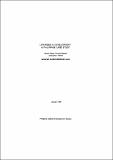| dc.contributor.author | Ranis, Gustav | |
| dc.contributor.author | Stewart, Frances | |
| dc.contributor.author | Reyes, Edna A. | |
| dc.coverage.spatial | Philippines | en_GB |
| dc.date.accessioned | 2014-04-25T10:53:11Z | |
| dc.date.available | 2014-04-25T10:53:11Z | |
| dc.date.issued | 1989 | |
| dc.identifier.citation | Ranis, G., F. Stewart & E.A. Reyes (1989) Linkages in development : a Philippine case study. Working paper series, 8902. Manila : PIDS. | en_GB |
| dc.identifier.uri | https://opendocs.ids.ac.uk/opendocs/handle/20.500.12413/3822 | |
| dc.description.abstract | The aim of this study is to provide an analysis of the interactions
between the sectors, integrating macro and micro approaches to these
interactions with special emphasis on the spatial dimension of development„
Most of the empirical work in the study concerns the Philippines, but the
conclusions are of much wider application, being relevant to many other
countries in the early and intermediate stages of development.
This study - which focuses primarily on the Philippines but also draws
on evidence from other Asian countries - brings together the diverse
elements in rural linkages, categorizes different types of linkage, and
draws on relevant micro-studies of linkages and their effects, so as to
improve our understanding of how linkages affect patterns of development,
and to identify some policy implications that follow.
The paper is organized as follows. Section II presents an analytic
categorization of linkages, with a discussion of the nature and direction
of causality between linkages and sectoral and aggregate growth. Sections
III - VII present some empirical evidence: Section III focuses on the
magnitude of non-agricultural income and employment in a number of Asian
countries; Section IV presents some evidence on the significance of
linkages based on micro-studies outside the Philippines, focusing
separately on two different directions of causality - first, on the ways
in which agricultural growth affects industry; and secondly, on the ways
in which industrial growth affects agricultural development. Section V
presents some aggregate evidence for the Philippines on the growth of the
agricultural and non-agricultural sectors, development strategies and
spatial developments. Section VI reviews and analyzes existing micro evidence on linkages in the Philippines. Here too we categorize evidence
into the two directions of causality noted above. Section VII presents
same evidence of our own on linkages from industry to agriculture in the
JBicol region of the Philippines. Section VIII contains our analytical and
policy conclusions on the significance of linkages. | en_GB |
| dc.language.iso | en | en_GB |
| dc.publisher | Philippine Institute for Development Studies | en_GB |
| dc.relation.ispartofseries | PIDS working paper series;8902 | |
| dc.rights.uri | http://creativecommons.org/licenses/by-nc-nd/3.0/ | en_GB |
| dc.subject | Agriculture | en_GB |
| dc.subject | Development Policy | en_GB |
| dc.subject | Industrial Development | en_GB |
| dc.title | Linkages in development : a Philippine case study | en_GB |
| dc.type | Series paper (non-IDS) | en_GB |
| dc.rights.holder | Philippine Institute for Development Studies | en_GB |
| dc.identifier.externaluri | http://www.pids.gov.ph/publications.php | en_GB |


